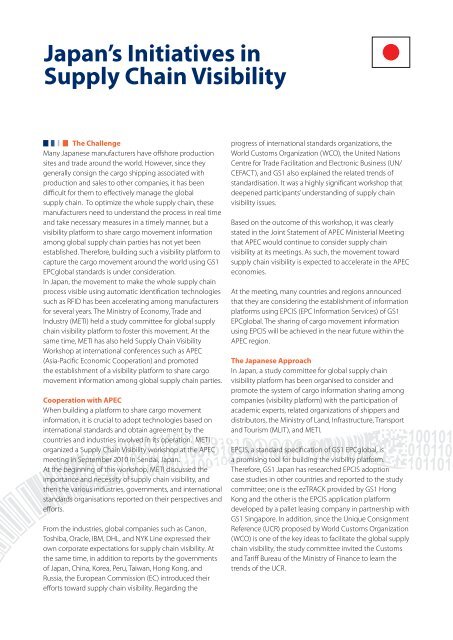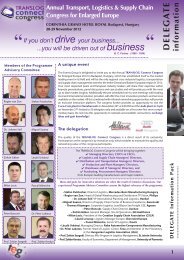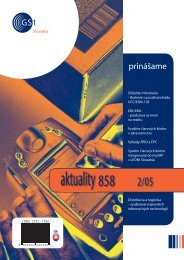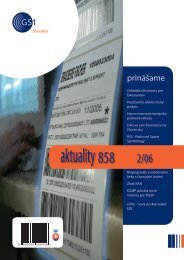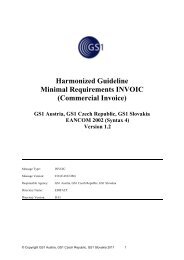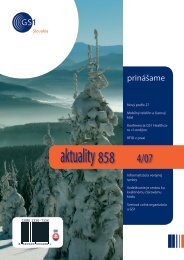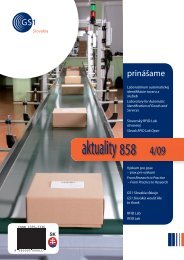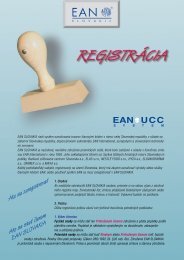GS1 StandardS in tranSport, LoGiSticS and cuStomS - GS1 Slovakia
GS1 StandardS in tranSport, LoGiSticS and cuStomS - GS1 Slovakia
GS1 StandardS in tranSport, LoGiSticS and cuStomS - GS1 Slovakia
You also want an ePaper? Increase the reach of your titles
YUMPU automatically turns print PDFs into web optimized ePapers that Google loves.
Japan’s Initiatives <strong>in</strong><br />
Supply Cha<strong>in</strong> Visibility<br />
The Challenge<br />
Many Japanese manufacturers have offshore production<br />
sites <strong>and</strong> trade around the world. However, s<strong>in</strong>ce they<br />
generally consign the cargo shipp<strong>in</strong>g associated with<br />
production <strong>and</strong> sales to other companies, it has been<br />
difficult for them to effectively manage the global<br />
supply cha<strong>in</strong>. To optimize the whole supply cha<strong>in</strong>, these<br />
manufacturers need to underst<strong>and</strong> the process <strong>in</strong> real time<br />
<strong>and</strong> take necessary measures <strong>in</strong> a timely manner, but a<br />
visibility platform to share cargo movement <strong>in</strong>formation<br />
among global supply cha<strong>in</strong> parties has not yet been<br />
established. Therefore, build<strong>in</strong>g such a visibility platform to<br />
capture the cargo movement around the world us<strong>in</strong>g <strong>GS1</strong><br />
EPCglobal st<strong>and</strong>ards is under consideration.<br />
In Japan, the movement to make the whole supply cha<strong>in</strong><br />
process visible us<strong>in</strong>g automatic identification technologies<br />
such as RFID has been accelerat<strong>in</strong>g among manufacturers<br />
for several years. The M<strong>in</strong>istry of Economy, Trade <strong>and</strong><br />
Industry (METI) held a study committee for global supply<br />
cha<strong>in</strong> visibility platform to foster this movement. At the<br />
same time, METI has also held Supply Cha<strong>in</strong> Visibility<br />
Workshop at <strong>in</strong>ternational conferences such as APEC<br />
(Asia-Pacific Economic Cooperation) <strong>and</strong> promoted<br />
the establishment of a visibility platform to share cargo<br />
movement <strong>in</strong>formation among global supply cha<strong>in</strong> parties.<br />
Cooperation with APEC<br />
When build<strong>in</strong>g a platform to share cargo movement<br />
<strong>in</strong>formation, it is crucial to adopt technologies based on<br />
<strong>in</strong>ternational st<strong>and</strong>ards <strong>and</strong> obta<strong>in</strong> agreement by the<br />
countries <strong>and</strong> <strong>in</strong>dustries <strong>in</strong>volved <strong>in</strong> its operation. METI<br />
organized a Supply Cha<strong>in</strong> Visibility workshop at the APEC<br />
meet<strong>in</strong>g <strong>in</strong> September 2010 <strong>in</strong> Sendai, Japan.<br />
At the beg<strong>in</strong>n<strong>in</strong>g of this workshop, METI discussed the<br />
importance <strong>and</strong> necessity of supply cha<strong>in</strong> visibility, <strong>and</strong><br />
then the various <strong>in</strong>dustries, governments, <strong>and</strong> <strong>in</strong>ternational<br />
st<strong>and</strong>ards organisations reported on their perspectives <strong>and</strong><br />
efforts.<br />
From the <strong>in</strong>dustries, global companies such as Canon,<br />
Toshiba, Oracle, IBM, DHL, <strong>and</strong> NYK L<strong>in</strong>e expressed their<br />
own corporate expectations for supply cha<strong>in</strong> visibility. At<br />
the same time, <strong>in</strong> addition to reports by the governments<br />
of Japan, Ch<strong>in</strong>a, Korea, Peru, Taiwan, Hong Kong, <strong>and</strong><br />
Russia, the European Commission (EC) <strong>in</strong>troduced their<br />
efforts toward supply cha<strong>in</strong> visibility. Regard<strong>in</strong>g the<br />
progress of <strong>in</strong>ternational st<strong>and</strong>ards organizations, the<br />
World Customs Organization (WCO), the United Nations<br />
Centre for Trade Facilitation <strong>and</strong> Electronic Bus<strong>in</strong>ess (UN/<br />
CEFACT), <strong>and</strong> <strong>GS1</strong> also expla<strong>in</strong>ed the related trends of<br />
st<strong>and</strong>ardisation. It was a highly significant workshop that<br />
deepened participants’ underst<strong>and</strong><strong>in</strong>g of supply cha<strong>in</strong><br />
visibility issues.<br />
Based on the outcome of this workshop, it was clearly<br />
stated <strong>in</strong> the Jo<strong>in</strong>t Statement of APEC M<strong>in</strong>isterial Meet<strong>in</strong>g<br />
that APEC would cont<strong>in</strong>ue to consider supply cha<strong>in</strong><br />
visibility at its meet<strong>in</strong>gs. As such, the movement toward<br />
supply cha<strong>in</strong> visibility is expected to accelerate <strong>in</strong> the APEC<br />
economies.<br />
At the meet<strong>in</strong>g, many countries <strong>and</strong> regions announced<br />
that they are consider<strong>in</strong>g the establishment of <strong>in</strong>formation<br />
platforms us<strong>in</strong>g EPCIS (EPC Information Services) of <strong>GS1</strong><br />
EPCglobal. The shar<strong>in</strong>g of cargo movement <strong>in</strong>formation<br />
us<strong>in</strong>g EPCIS will be achieved <strong>in</strong> the near future with<strong>in</strong> the<br />
APEC region.<br />
The Japanese Approach<br />
In Japan, a study committee for global supply cha<strong>in</strong><br />
visibility platform has been organised to consider <strong>and</strong><br />
promote the system of cargo <strong>in</strong>formation shar<strong>in</strong>g among<br />
companies (visibility platform) with the participation of<br />
academic experts, related organizations of shippers <strong>and</strong><br />
distributors, the M<strong>in</strong>istry of L<strong>and</strong>, Infrastructure, Transport<br />
<strong>and</strong> Tourism (MLIT), <strong>and</strong> METI.<br />
EPCIS, a st<strong>and</strong>ard specification of <strong>GS1</strong> EPCglobal, is<br />
a promis<strong>in</strong>g tool for build<strong>in</strong>g the visibility platform.<br />
Therefore, <strong>GS1</strong> Japan has researched EPCIS adoption<br />
case studies <strong>in</strong> other countries <strong>and</strong> reported to the study<br />
committee; one is the ezTRACK provided by <strong>GS1</strong> Hong<br />
Kong <strong>and</strong> the other is the EPCIS application platform<br />
developed by a pallet leas<strong>in</strong>g company <strong>in</strong> partnership with<br />
<strong>GS1</strong> S<strong>in</strong>gapore. In addition, s<strong>in</strong>ce the Unique Consignment<br />
Reference (UCR) proposed by World Customs Organization<br />
(WCO) is one of the key ideas to facilitate the global supply<br />
cha<strong>in</strong> visibility, the study committee <strong>in</strong>vited the Customs<br />
<strong>and</strong> Tariff Bureau of the M<strong>in</strong>istry of F<strong>in</strong>ance to learn the<br />
trends of the UCR.


